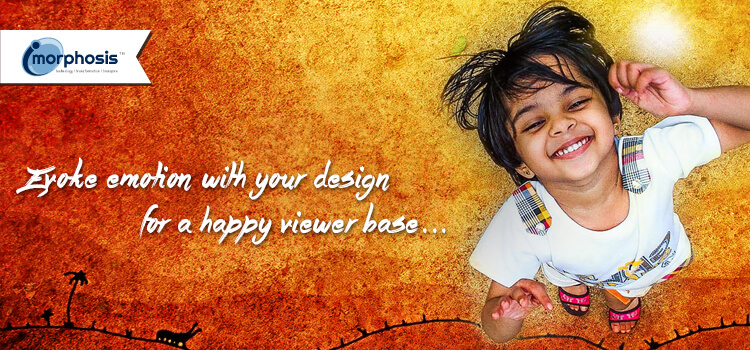Human are full of emotions. On seeing something beautiful and interesting they are attracted to it. Frightening things make their heart beat faster, hands clench in fear. While designing, you need to consider the human characteristics and specifically the riot of emotions they face.
It is important for designers to build a deep emotional connection with their audiences and create a magical experience for them. To create the magic, designers need to change the way they share ideas and communicate with their audiences. There are various ingredients to make a perfect website design- colors, typography and content. But you need to identify the secret ingredient to create a deep impact on the visitors so that they keep coming back!
Now what is this secret ingredient? Simple, just evoke emotions of viewers. Designers need to evoke emotions like Joy, Surprise, Disgust, Sadness, Fear, Anger, Attention and Trust with their visual creations.
Importance of Emotional Design
The aim of an emotional design is to forge a relationship with the audiences. That is, the design need to create an emotional connection with the audience and instill trust in them. It is important for designers to understand how visual messages relate to human emotions, so that they can convey meaning as intended.
An effective emotional design should have a human-first approach. Companies and brands now emphasize on telling a story of every product through the website design. So, the web design should echo the personality of a brand or product. Since the initial years of advertising experts have employed this trick to build trust and sell more products.
Yes, evoking emotions is the key! The focus of a design is simplicity as it is always easy to trigger a single emotion of the viewers. Limiting the choice of audiences and then evoking their emotion urges them to share their feelings with others.
Designers need to ensure that their creations speak emotions and start an interaction. Design should be easily understood, visually appealing, memorable, personal and enjoyable. An emotion based web design must convey
- Trust – The look of a website creates the first impression on the mind of viewers. Design should instill trust in the potential customers. A poor combination of colors, misplaced Call-To-Action buttons or irrelevant images can prove to be repulsive for the viewers.
- Functionality – The website should have a seamless navigation so that viewers can accomplish what they are expected to achieve.
- Add value – The design needs to provide a glimpse about the products to the viewers and lets them decide whether it is worth trying.
Implementing these principles help designers to transform visitors to brand evangelists. Attaching human attributes to non-human elements evoke emotion of the website viewers. An emotional design attracts viewers and make them feel good.
Human Element in Designing
Emotion that a person feels while interacting with a website is of paramount importance as it decides their future actions. Integrating various human emotions into designing will create a deep impact on the psyche of the viewers.
A glimpse of how an emotional design impact human psyche
- Joy – When viewers see a happy design, they share it through different communication media. Happy aesthetics connect people as it makes them feel good and positive. For instance a smiling face on the landing page of a website will have a happy response.
- Sadness – Similarly, sad visuals also connect as it urges a feeling of empathy. A majority of users reacts to sad visual messages, if they trust the message, they might even reach out to those who need it.
- Surprise – Surprise creates a connection with viewers, as it makes things interesting and helps in accomplishing the goal. It creates a series of different emotions as with both happiness and fear are associated with it.
- Disgust – If the visual is not trustworthy enough, your viewers will consider it disgusting. The emotion makes it difficult for the viewers believe the message conveyed through the visual or relate to it.
- Fear – Fear is a tricky emotion, usually immediate response of this emotion is to flee the scene, but obviously you do not want your audience to do so when they see your design. It is advisable to connect with viewers through the website. You can make them feel secure by portraying the fear of others.
- Anger – Anger has a both long lasting and negative impact on the viewers. However, the response of images depicting anger is also unpredictable, it might result in stubbornness or aggression.
- Attention – A personalized treatment to the customers will attract the attention of visitors. They will appreciate and recall it.
- Trust – For instilling trust, use visuals that users can relate to and hints at trustworthiness. Many brands use images of a baby as it evokes trust and creates an emotional connect with the target audience. The image of a child’s face lets the viewers’ submit wholeheartedly. Few companies also use cartoons with the same objective.
An emotional design is a unique way of making your website stand apart from others. So, designers need to consider the human element while designing right from the ideation stage.
Role of Color in an Emotional Design
Color plays an important role in designing. Since Middle Ages, scientist have studied the psychological effect of colors. Every color is unique and has a different impact on the emotion of human users.
The vibrancy of colors is another important factor that designers need to consider. Different shades have noteworthy impact on web designing. As a rule of thumb, brighter shades are more energetic and dark shades are relaxing. For Call-To-Actions, brighter shades are appropriate and dark shades as backgrounds create a striking effect on the users.
Know what each color stands for and emotions that different shades of each color evoke.
- Black– Black, the strongest color is sophisticated and powerful. For backgrounds it acts as the primary color and is often used for text of a website. It also stands for mystery. Heavy use of this color often turns out to be scary.
- White – White is an ideal secondary color that denotes virtue. It gives an impression of chastity, clean and spotless. Holiness is associated with white.
- Red – Red stands for something important, aggressive and passionate. It heightens awareness and adds gravity. Designers need to use this color cautiously. But, if you want to attract attention, then this is the best tool. Lighter shades of red indicate youth and dark symbolizes power.
- Yellow – Yellow is strange, it stands for friendship, happiness as well as a warning. It stimulates the human brain. Lighter yellow represents a sunny day and happiness, whereas the darker shade adds gravity.
- Orange – Orange is energetic, playful and cheap. The color is an effective way of adding playfulness and excitement to the design. It signifies vibrancy and vitality.
- Green – Green represents prosperity and nature. Since the color stands for stability, it serves as a bridge between warm colors like red, yellow, orange and cool colors like purple and blue. To stand out from other buttons on the website, this color is used for Call-to-Action.
- Purple – Purple is a romantic color that has long been associated with luxury and royalty. The extensive use of purple creates a sense of elegance and symbolizes creativity. The lighter shade of purple is more romantic in nature while darkening the shade makes it sensual.
- Blue – Many websites use blue as it symbolizes serenity and trustworthiness. It evokes a sense of safety and security. In comparison to the other colors, it is a versatile color and different shades of it have an intense impact on the human psyche. Light blue denotes sky, water and is refreshing to the human eyes. Dark blue is somber, reflects professionalism and security.
- Brown – Brown has a more rustic effect, it is associated with trees and earth. When paired with green, it provides an outdoor effect. In web designing, brown creates an old-fashioned feeling in the mind of the users.
Various research and studies has proved the effect of each color on the human psyche as described above. Different companies and brands use these theories while designing the logos and website. The choice of the color should however depend on the mood of the target audience that you want to create. So, while creating an emotional design, be careful about choosing the perfect color as well as the hue of each color.
Tips of Emotional Designing
It is important for a brand to have a long-term, trustworthy relationship with their users. To make your design connect emotionally with your viewers or users, there are few quick fixes.
- Research proves that people remember TV commercials that are humorous, than the serious ones. The same theory is true for website designing. So, use visuals that will make your audiences laugh. Already many brands are implementing the same while designing their websites. You might have noticed few hand-drawn funny sketches in the website of many companies and it aims at making people laugh.
- Human nature is such that they like things that they can predict, so use patterns and visuals that they expect. Also, add elements of surprise as to keep the users on toes, but ensure that the surprise element should be minimum.
- Usually, humans are attracted to things they can relate. It is better to use visuals that they can relate to.
The aim of emotional design is to engage users and connect with them as it is the key to success. A good design attracts the attention, and is effective, memorable and pleasurable for the audiences. Integrating correct emotions, colors and following the effective tips while designing will make the users feel good. To make the website stand out from others, designers need to create visual elements that appeal the users and evoke their emotions.






Pingback: How to create an Emotional Design to attract yo...()